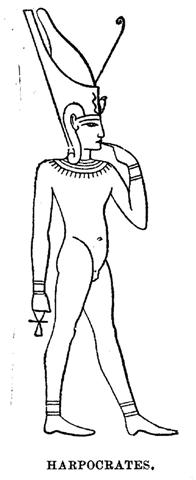Having established a preliminary model for comparing a few of the old Egyptian images with similar ones in the rongorongo system we are now able to move on. Harpocrates, the Sun child at the horizon in the east, has a significant lock of hair which in form is not very different from some of the toki signs:  We can for instance compare with those in Ea1-24, Ga2-1 and Qa6-29:
I think the S-formed hair lock was meant to show how the path of the sun leads him from the back side to the top of the front side, where he reemerges in full view. Hair is a characteristic of the back of the head. 'Dawn' in the east is where spring sun reemerges. Another (second) 'dawn' is reasonable to find in the 'blue world', which could explain tagata toki in Qa6-29. On Easter Island this 'blue world' must be north of the equator. Egyptian images allow internal descriptions, but not so on Easter Island - only the outlines of the entities can be described in rongorongo glyphs. A corresponding sign had to be an outline sign and it must be on the left side (because Harpocrates had his lock on the right side of his head). In the picture above his hair lock ends inside a double (2) hair band, and below comes his face. The hair band presumably signifies the Moon (cloth and 2 bands). Possibly it meant that spring sun was not to appear until after 2 months (or 2 fortnights). In another picture of Harpocrates (from Wikipedia) his hairlock and his sucking on his index finger are even more accentuated:
If one finger is put into his mouth only 3 (excepting the thumb which is of another sort) remain visible. Sucking the index of the right hand implies that only the left arm is free. These numbers we can recognize: 3 refers to spring and Sun has only one 'leg' (here arm). In the rongorongo system arms become legs. 3 are also the number of rings around his right arm. They could indicate 3 doublemonths of autumn, but I guess they are expressing 3 periods of spring. The gesture with index finger into mouth presumably alludes to 'eating'. Harpocrates is hungry. The hair lock is very prominent. The Serpentine sign of spring is still used in the Swedish yellow buns of December 13 (Lucia), which once was the time when Sun was turning around to begin his journey of ascent. Precession moves dates earlier. Such a bun is called 'Lusse-katt' which means a 'cat' which is eaten at Lucia:
(picture from Wikipedia) The bun in the picture has obviously been baked by someone who was unaware of the meanings of signs. The bun is not formed into S but into its opposite. The black 'pupils' (raisins) indicate the dark central holes of the 'whirlpool' seen from north respectively from south. Dark Holes in the sky is no new discovery. |
|||||||||||||||||||||||||||||||||||||||||||||||||||||||||










